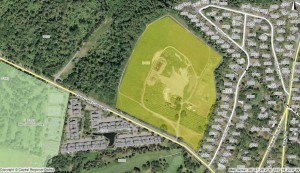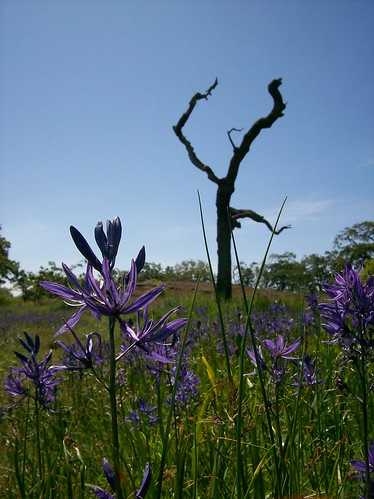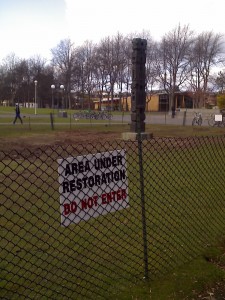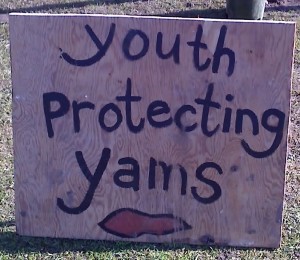That Preston Manning, late of the of the federal Reform party and more recently of the Fraser Institute, would show up at a sustainability conference is a bit of cognitive dissonance. After all, his old party barely believes in anthropogenic global warming and is a whole-hearted supporter of Alberta’s oil sands, a major cause of Canada’s rising emissions. But come he did, to talk about reconciling environmental and economic viewpoints, largely from a Christian perspective. Along side him was Paul Williams, Executive Director of the Regent College Marketplace Institute, and two gentlemen from A Rocha, a Christian sustainability outfit.
The talk was well attended, surprising given it was running into the teeth of Stewart Brand and his Whole Earth Discipline – the Eco-pragmatist’s Manifest talk, a far more likely speaker and topic at a sustainability conference. I wonder how many people were here because they just wanted to see what Preston would say and how any actually were here because they believed in what Preston said or did. The room seemed evenly split between the suits and the hippies, so I suspect it was a bit of both.
Up first was Paul, who laid out the ground work, basically as thus: it was the best of times, it was the worst of times. Or stated differently, our economy is going great but we are driving off an environmental cliff and here are the two different stories in each city. He then invoked some stereotypes in telling his story, as seen from the table below:
|
Economic |
Enviromental |
Christian |
| Assumptions |
free choice of individuals & firms |
ecological damage, human economy breaching limits |
command (but failure) to steward Creation in community |
| Purpose |
happiness through wealth creation as success |
sustainable balance of ecosystems, survival |
(restoration) maturation of right relationships, Shalom |
| Practices |
maximization of profit/growth, consumption |
minimization (of harm & damage), conservation |
worship – god, people, creation – cultivation |
| Virtues |
efficiency, diligence, selfishness, greed |
efficiencty, care, anxiety, blame |
thanksgiving, generosity, creativity |
| Unit of Measure |
money |
resources/energy |
relational |
| Policy Paradigm |
market deregulation |
state regulation |
local market scope |
It certainly is a neat little table, but I think large parts of it are wrong. Take the statement that the core assumption of economic development is liberty. Why is this wrong? There are the stellar examples of mainland China (or Korea and Taiwan to a lesser extent earlier in the 20th century). None of these economies sought out liberty in any sense, yet all strove for standard, 20th-century economic development – growth of GDP, productivity, etc. And all three succeeded, without much (initial) political freedom.
But at the core, I think he does have some good points. He did point out that there is no reason why the units of measure between the envirnomental story and the economic one need to be separated. In fact, for most of human history they were. (Insert conspiracy about abandoning gold standard here).
And while his ideas about thanksgiving being a good counter-point to the commercial consume message might be good, I think narrowly defining the Christian message as the one between the two “extremes” does a great deal of disservice to everybody. But he did give a great deal to think about and presents some interesting challenges to people of faith and not.
Up next was Preston, described as “one of Canada’s great political visionaries”. He digressed slightly at times, but overall he stuck to three core ideas: the need to create and manage non-political forums, the need to mediate between interests, and lastly but most importantly — at least in my mind — the need to model reduction.
It turns out Preston is actually pretty moderate when it comes to the oil sands. Just take at a look at what he has said: National Post story, Saskatoon Star Pheonix story. Guess being out of power, as it were, allows you to speak more freely.
Back to the idea of reduction. He said that people of faith should work on the demand side, because lots of work already being done on the supply side, with little done on the demand side. An example: electrics cars are great, but nobody is asking if a car is really needed. And faith can play a central roll here: jesus teaches accumulating spiritual wealth than real world wealth. (Luke 12:15 NIV – Then he said to them, “Watch out! Be on your guard against all kinds of greed; a man’s life does not consist in the abundance of his possessions.” )
Sadly I had to leave right as Preston ended (he had a much shorter talk than Paul) because I am up tomorrow at 6am to help volunteer for the conference. Hope to see you all there.
Thriving within Limits: Ecologically informed economics and the
sustainability ohttp://www.arocha.org/ca-en/g2/8396-DSY.htmlf cities



